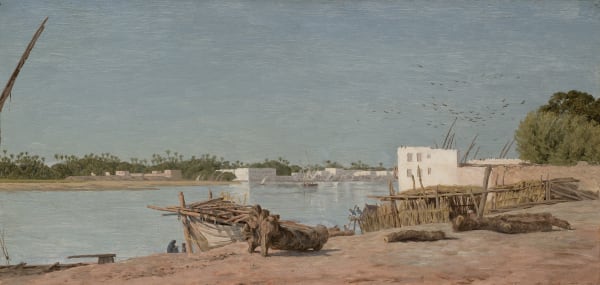George Price Boyce (1826-1897)
Whilst sketching in Whitby in the summer of 1861, Boyce rushed back to London to see his sister before she died in the middle of July. In October he travelled to Egypt in the company of E.S.Lundgren (1815-75), the Swedish painter, and Frank Dillon (1823-1909), a pupil of James Holland. Boyce’s topographical work included for the greater part views of Egyptian temples and ruins’ (Surtees, p. 94). 'These three artists hired a house in Gizeh on the riverbank, and there they lived for a time in Oriental fashion. [Lundgren's] letters describe the native hospitality they received from a young Egyptian, Iscander Bey, son of the late Solomon Pasha, visits to the Boulay Museum and the Sphinx's head, and an English picnic at the pyramid of Cheops.' JL Roget A History of the Old Watercolour Society, 1891, Volume II, p 405)
A point of interest is that Thomas Seddon’s 1821-1856 ‘The Great Sphinx at the pyramids of Ghizeh’ (Ashmolean Museum, Oxford) of 1854 belonged to Boyce.The Al-Hakim Mosque was originally built as an enclosure by the Fatimid vizier Gawhar Al-Siqilli (c.928-992) but was later incorporated into the extended fortifications built by Badr al-Jamali. It is named after Imam Al-Hakim bi-Amr Allah (985-1021), the sixth Fatimid caliph. Boyce shows in his watercolours one of the two minarets on either side of the façade, the earliest surviving minarets in the city. At various times the mosque was used as a prison for captured Crusaders, as a stable by Saladin, as a fortress by Napoleon, and as a local school. As a result, by the time Boyce made his visit the mosque had fallen out of use and was in a state of ruin. In 1980 the mosque was extensively refurbished in white marble and has returned to being a place of worship.
The Maas Gallery, 6 Duke Street, St. James's, London, SW1Y 6BN
+44 (0) 20 7930 9511 | mail@maasgallery.com
This website uses cookies
This site uses cookies to help make it more useful to you. Please contact us to find out more about our Cookie Policy.


